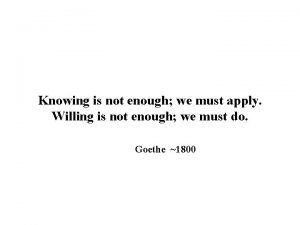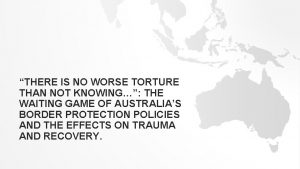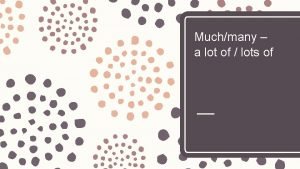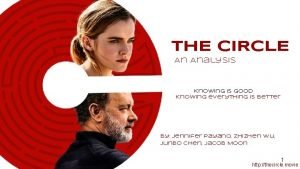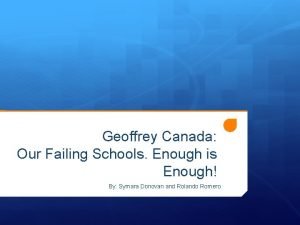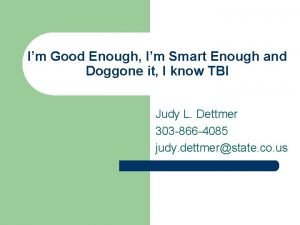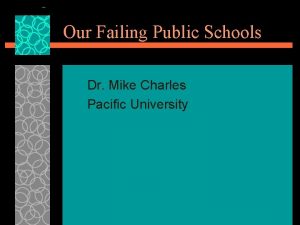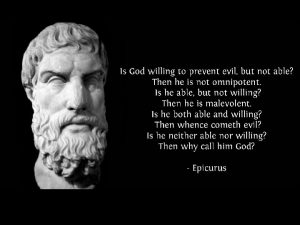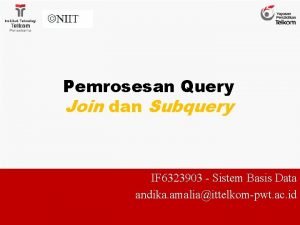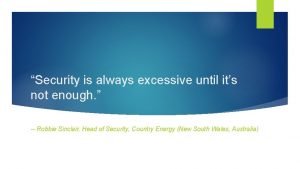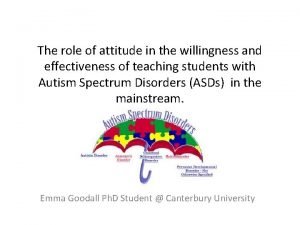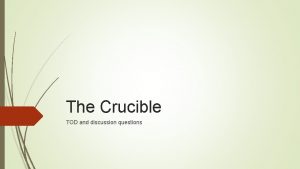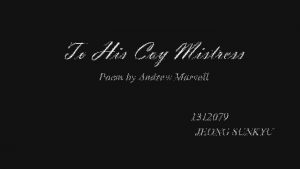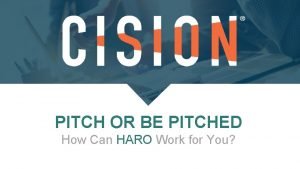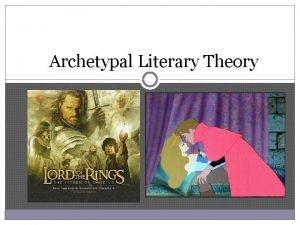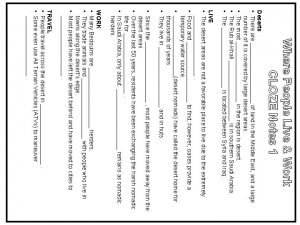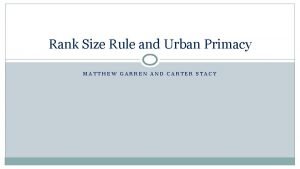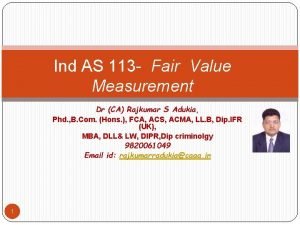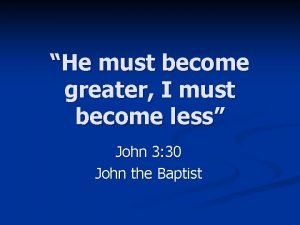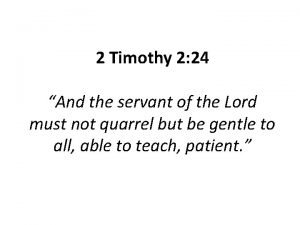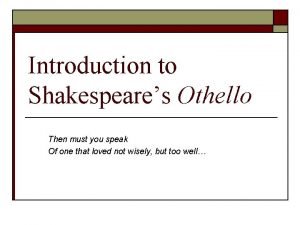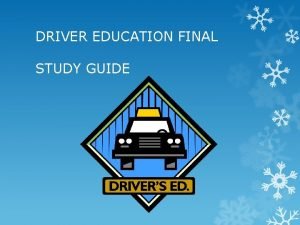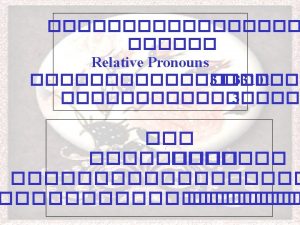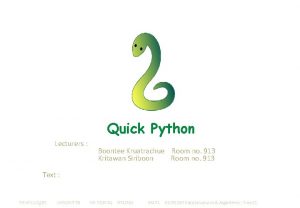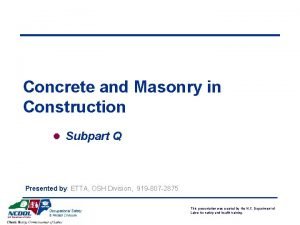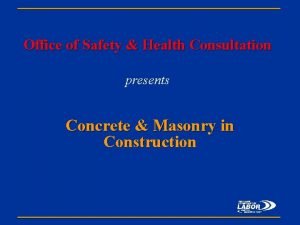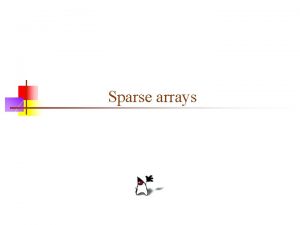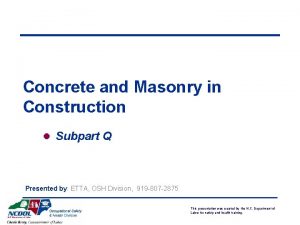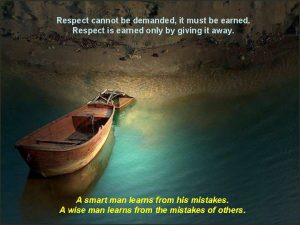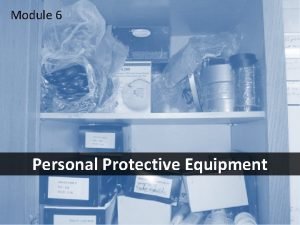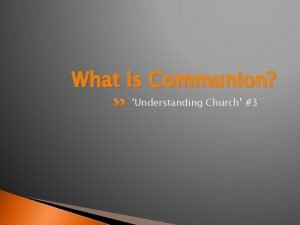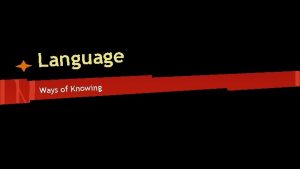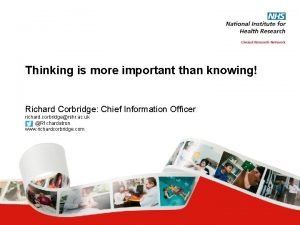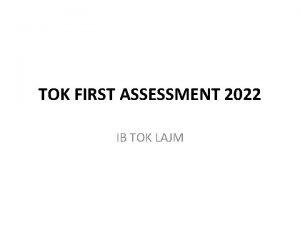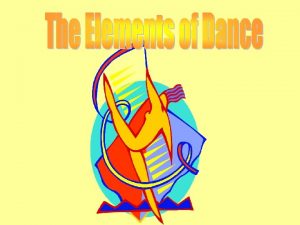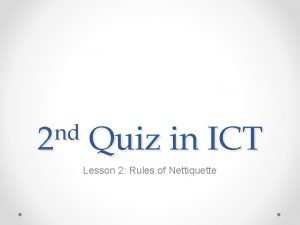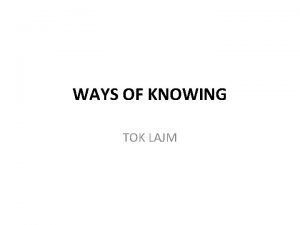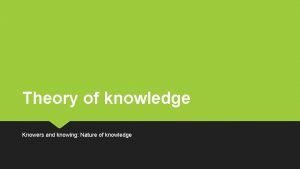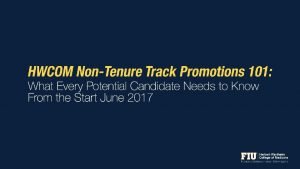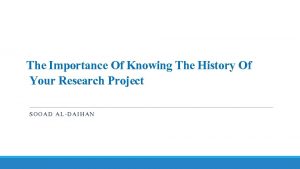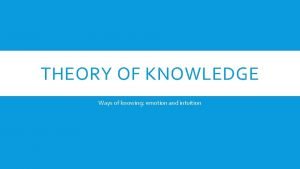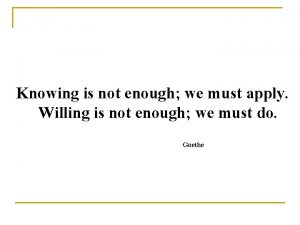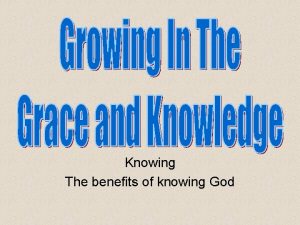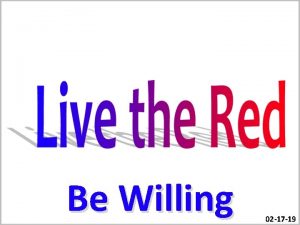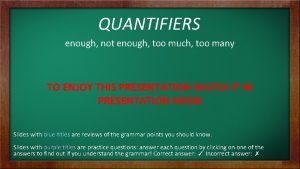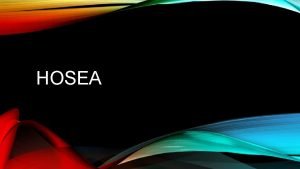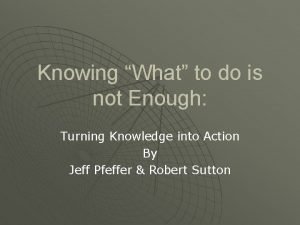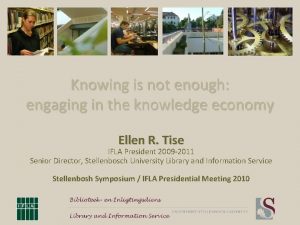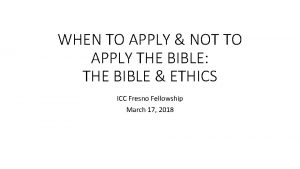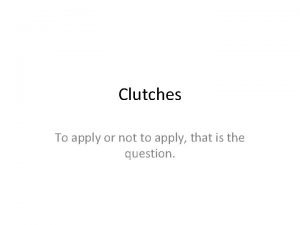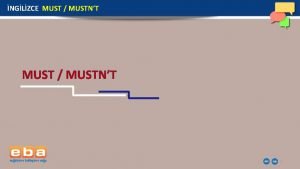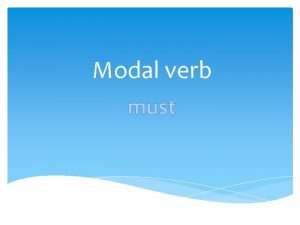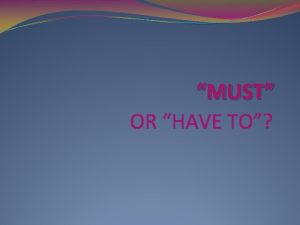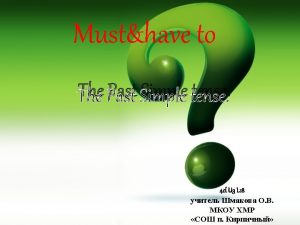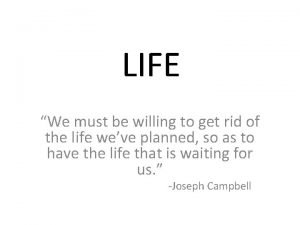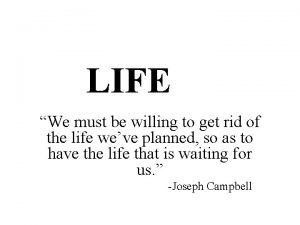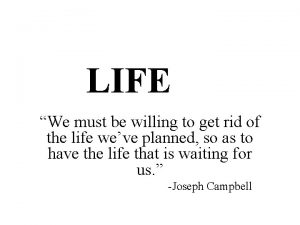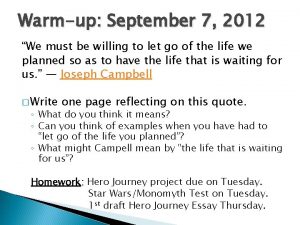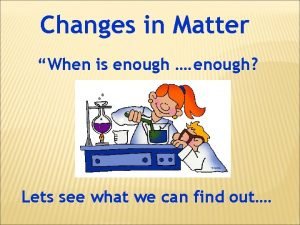Knowing is not enough we must apply Willing























































- Slides: 55

Knowing is not enough; we must apply. Willing is not enough; we must do. Goethe ~1800

Directors of Clinical Skills Courses Back to the Future: Clinical Skills Education …some food for thought Eugene C. Corbett Jr. , M. D. , M. A. C. P. Brodie Professor Emeritus of Medicine, Nursing University of Virginia School of Medicine ecc 9 h@virginia. edu

Plenary Agenda • You & me • A William Wordsworth idea • Some historical perspective on clinical skills education • Hedgehogs & Foxes • Some workshop food-for-thought • Some thanking to do!

Directors of Clinical Skills Courses: Your work is most essential !! My heart leaps up when I behold A rainbow in the sky. So it was when my life began; So is it now I am a man; So be it when I grow old, Or let me die! The Child is the Father of the Man; And I could wish my days to be Bound each to each by natural piety. William Wordsworth 1802

Thomas Bond 1752 “Realizing that the student “must Join Examples with Study, before he can be sufficiently qualified to prescribe for the sick, for Language and Books alone Can never give him Adequate Ideas of Diseases and the best methods of Treating them”, [Thomas] Bond now argued successfully in behalf of his bedside training for the medical students…The writer of these sensible words fitly became our first professor of clinical medicine, with unobstructed access to the one hundred and thirty patients then in the hospital wards. ” U Penn, by A. Flexner, 1910

Abraham Flexner 1910 “On the pedagogic side, modern medicine, like all scientific teaching, is characterized by activity. The student no longer merely watches, listens, memorizes: he does. His own activities in the laboratory and in the clinic are the main factors in his instruction and discipline. An education in medicine nowadays involves both learning and learning how; the student cannot effectively know, unless he knows how. ”

William Osler 1910 “In what may be called the natural method of teaching, the student begins with the patient, continues with the patient, and ends his studies with the patient, using books and lectures as tools, as means to an end. The student starts, in fact, as a practitioner, as an observer of disordered machines, with the structure and orderly functions of which he is perfectly familiar. Teach him how to observe, give him plenty of facts to observe and the lessons will come out of the facts themselves. For the junior student in medicine and surgery it is a safe rule to have no teaching without a patient for a text, and the best teaching is that taught by the patient himself. The whole art of medicine is in observation, as the old motto goes, but to educate the eye to see, the ear to hear and the finger to feel takes time, and to make a beginning, to start a man on the right path, is all that we can do. We expect too much of the student and we try to teach him too much. Give him good methods and a proper point of view, and all other things will be added, as his experience grows. ”

Table 1: AAMC Reports on Undergraduate Medical Education The Clinical Skills Education of Medical Students REPORT QUOTE Future Directions for Medical Education (AMA, 1982)[1] The sum of required clinical clerkship experiences should be acquisition by each student of the clinical skills necessary to provide general medical care under supervision (pg 14) Physicians for the 21 st Century The GPEP Report Working Group on Fundamental Skills (AAMC, 1984) 2 The clinical skills of graduating students fall considerably short of what could be achieved (pg 3). Medical faculties should develop procedures and incorporate explicit criteria for the systematic evaluation of students’ clinical performance (pg 17). Clinical Education and the Doctor of Tomorrow (Macy/NYAS, 1988) 3 Require medical students to pass comprehensive, performance-based clinical examinations. (pg 112) ACME-TRI Report Educating Medical Students (AAMC, 1992) 4 Formally assess clinical skills (pg 26) The Education of Medical Students: Ten Stories of Curriculum Change (AAMC/Milbank Mem Fund, 2000) 5 . . . at the time of graduation, medical students too often lack fundamental clinical skills that they should have acquired during their clinical education (pg 1). . . changes in the clinical environments where medicine is learned have undermined the quality of the teaching that occurs in those environments (pg 8). The AAMC Project on the Clinical Education of Medical Students (2001) 6 In most schools, there is inadequate attention paid to ensuring that students acquire fundamental clinical skills (pg 9). (a major concern) The lack of adequate teaching of fundamental clinical skills, including rigorously conducted formative assessments of students performances (pg 13).

AAMC Survey of Curriculum Deans 2002 For what years of your medical school curriculum is there an explicit clinical skills curriculum? Dean’s Survey 10/02: Year 1 2 Year 2 19 Year 3 8 Year 4 3 AAMC Curriculum Database 2000: “clinical skills sessions” 3/1 9/2 2/3 “clinical skills courses” 3/1 21/23/3

AAMC Survey of Curriculum Deans 2002 Do you have a specific list of medical school objectives with which to organize and guide clinical skills education? {This is used by the minority of schools despite LCME influences} Dean’s Survey: 17/62 (27%) LCME ’ 02 Data: 15/59 (25%)

AAMC Survey of Curriculum Deans* Does your medical school have a document that specifies the clinical skills that all students are expected to acquire before graduation? Yes 44% No 53% Communication History-taking Physical Examination Clinical Testing Procedures * Response Rate = 62/142 (44%) 19% 21% 17% 23% 26%

AAMC Survey of Curricular Deans 2002 In your medical school, is there a formal clinical skills assessment in year 3 or 4? Dean’s Survey: LCME ’ 02 data: 36/53 (68%) 71/125 (57%) Direct Observation Paper & Pencil OSCE/SP Computer Sim 25 % 20 % 67 % 8 %

AAMC Survey of Curriculum Deans 2002 Does your medical school have a special facility that is dedicated to the teaching & assessment of clinical skills? n = 57/62 Yes 59% (3 shared) No 23% Not yet 15%

LCME Table 5: Trends in Final Clinical Skills Assessment Methods (LCME, n =125) METHOD 93 -94 94 -95 98 -99 01 -02 Direct Observation 13 15 16 25 Paper & Pencil 23 22 12 20 SP/OSCE 26 32 49 67 Computer Simulation 5 3 7 8 Oral Examination 11 5 No data


# Students Old Curriculum # Students Overall Score on 4 th Year Clinical Skills Assessment New Curriculum

DUTCH CLINICAL SKILLS OUTCOMES

Table 7: Clinical Skills Evaluation Methods Percent of students reporting use of each method: n=839 Total Traditional Frequency School Skills-Oriented School Difference p value METHOD Resident Observation 749 87% 92% 0. 03 NBME Shelf Exam 747 89% >. 05 Faculty Observation 719 81% 92% <. 0001 Oral Examination 683 80% 83% >. 05 Multiple Choice Exam 682 79% 86% 0. 01 OSCE 481 42% 80% <. 0001 Computer Case Simulation 444 39% 75% <. 0001 Peer Evaluation 215 15% 43% <. 0001 Computer Skill Simulation 131 12% 21% . 0004 Four schools in each group: (Traditional= no skills center, maybe a skills document or skills assessment: AECOM, Gtwn, Tx. AM, Va) (Clinical Skills-oriented= skills center + skills document + skills assessment: Brown, MSSM, UConn, UFla) Data from 2002 AAMC Graduation Questionnaire, question #13

UVA: Direct Observation of Clerkship Students 1999 -2001 Students reporting that they had NEVER been observed by a faculty member while: 1. taking a history: 51% 2. performing a focused physical exam: 54% 3. performing a complete physical exam: 60% L Howley and WG Wilson, Academic Medicine, 2004

A 4 th Year Medical Student UVA 2004 “While in medical school we are continually encouraged to master a common body of knowledge, we are not as expected to master clinical skills. After reviewing my performance on videotape, I realize that I also have to master the skills of the patient encounter. ”

CLERKSHIP CLINICAL SKILLS EDUCATION PROJECT 2004 How often is there opportunity for skill practice in the clerkship? (student opinion asked at the time of the assessment)

CLERKSHIP CLINICAL SKILLS EDUCATION PROJECT 2005 Overall Student Skill Performance (as judged by faculty observer):

Patterns of skill performance on the Arrhythmia Recognition OSCE Did the student perform the critical clinical action? UVa 2008 Critical Action performed Critical Action omitted 37. 8% 62. 2% Higher scoring students 31. 1% 17. 8 % 13. 3 % Lower scoring students 68. 99. 8% 20. 0 % 48. 9 %

UVA Post-clerkship OSCE data (2008) Skill Score Above the Median Score Below the Median Critical Action Correct Critical Action Incorrect Detect an Arrhythmia (n=45) 17. 8% 13. 3% 20% 48. 9% Maintain Aseptic Technique (n=110) 1. 8% 46. 4% 0% 51. 8% Measure Blood Pressure (n=119) 35. 3% 10. 1% 28. 6% 26. 0% Maintain Confidentiality (n=118) 22. 0% 0% 4. 3% 73. 7% Perform an ECG (n=26) 3. 8% 42. 3% 0% 53. 9% Phone Triage an Infant with Fever (n=23) 26. 1% 21. 7% 0% 52. 2% Communicate Through an Interpreter (n=41) 4. 9% 21. 9% 9. 8% 63. 4% Manage a Medical Error (n=46) 26. 1% 21. 7% 2. 2% 50. 0% Examine Child’s Ears (n=33) 30. 3% 18. 2% 0% 51. 5% Auscultate the Second Heart Sound (n=33) 30. 3% 6. 1% 9. 1% 54. 5%

A Professional Paradigm Shift: From Process to Outcome ~2000 • • AAMC: Clinical Skills Education NBME Clinical Skills Examination LCME: Explicit Objectives of Medical Education LCME: Students’ Clinical Experience ACGME: Postgraduate Competencies IOM: Medical Error JCAHO: Hospital Performance Measures 3 rd Party Payors: Physician Performance

The educational paradigm shift for undergraduate medical education: From…”to know and understand” To…”understand apply”

AAMC Task Force on the Clinical Skills Education of Medical Students 2003 Purpose: To initiate the development of a national consensus regarding the teaching & learning of clinical skills in undergraduate medical education.

AAMC Task Force on the Clinical Skills Education of Medical Students 2003 • American Academy on Physician & Patient (AAPP) • Alliance for Clinical Education (ACE) • Association of Directors of Medical Student Education in Psychiatry (ADMSEP) • Association of Professors of Gynecology & Obstetrics (APGO) • Association for Surgical Education (ASE) • Clerkship Directors in Internal Medicine (CDIM) • Consortium of Neurology Clerkship Directors (CNCD, AAN) • Council of Medical Student Education in Pediatrics (COMSEP) • Society of Teachers of Family Medicine (STFM) & the AAMC

What is a “Clinical Skill” ? A CLINICAL SKILL IS A DISCRETE AND OBSERVABLE ACT OF CLINICAL CARE • It involves learner PERFORMANCE • It requires that a trained OBSERVER determine professional competency

AAMC Task Force on the Clinical Skills Education of Medical Students Basic 2003 -05 Preclerkship 2005 -08 Six Overall Recommendations: 1. Principles of Skills Education 2. Clinical Skill Education Objectives (#12) 3. A Menu of Skills 4. Clinical Learning Opportunities (Venues of Care) 5. A Developmental Paradigm (Levels of Performance) 6. Essential Programmatic Elements

A Clinical Skills Curriculum: Eight Essentials for Learning How to Do AAMC Clinical Skills Monographs 2005, 2008 • • 1. Learning Objectives (clinical method) 2. A List of Specific Skills for Learning 3. Teachers/Mentors, and the modeling influence 4. Encourage & model Self-directed Learning 5. Learning & Repetitive Practice Opportunities 6. A Skills Assessment Process 7 A Skills Remediation Plan 8 A 4 -year Developmental Education Strategy

DOCS Workshop Themes • • • Competencies & Strategies for Teaching Clinical Skills Challenges & Solutions for Faculty Development Clinical Skills & Science: Research & Evaluation Clinical Skills Curricula vs Clinical Practice Foundations for Case-Based Clinical Skills Examinations

Hedgehogs and Foxes “The fox knows many things, but the hedgehog knows one big thing. ” Archilochus 7 b. c. e. “Isaiah Berlin divides writers and thinkers into two categories: hedgehogs who view the world through the lens of a single defining idea, and foxes who draw on a wide variety of experiences…” Wikipedia 2012 (see The Hedgehog and the Fox. Isaiah Berlin, 1953)

9 Challenges & Unfinished Matters to consider… • • • What skills to teach & learn Levels of skill learning: keep it simple Beware the Snippet Syndrome Bass akwards: observation skill Workplace learning diplopia A clinical fidelity matter UGME-GME competency continuity A student diplopia challenge Resident & faculty development

What specific clinical skills should be learned in UME? There are hundreds! see AAMC Task Force Recommendations Appendices 2005 (~500), 2008 (~170) https: //www. aamc. org/initiatives/clinicalskills/

Levels of Clinical Skill Ability There’s Bloom’s Taxonomy, Miller’s Pyramid, Dreyfus Levels, Pangaro’s RIME, And then there’s this… • “Needs to do” • “Nice to do” • “Nuts to do”

The Medical Student 4 -Year Curriculum 1910 • • • Anatomy Physiology Chemistry Embryology Histology Bacteriology Pathology Hygiene Materia Medica • • Physical Diagnosis General etiology & Symptomatology Minor surgery & bandaging Medicine (incl dermatology, nervous & mental, diseases of children, dispensary medicine) Surgery (incl ophthalmology, laryngology, genitourinary, orthopedics) Obstetrics & Gynecology Preventive Medicine Therapeutics

The Medical Student 4 -Year Curriculum 2010 • • • • Anatomy Physiology Biochemistry Molecular & Cellular Function Embryology Histology Microbiology Neuroscience Human Behavior Genetics Pathology Pharmacology Physical Diagnosis Introduction to Clinical Medicine Epidemiology • • • Surgery Medicine Pediatrics Obstetrics & Gynecology Pediatric Specialties Radiology Family Medicine Psychiatry Neurology Emergency Medicine Dermatology Ophthalmology Otolaryngology Urology Orthopedics Plastic Surgery Physical Medicine & Rehabilitation Cardiology Gastroenterology Rheumatology Hematology Endocrinology Neurosurgery Oncology Geriatrics Nephrology Anesthesiology Health Policy, Economics…. etc…

The UME – GME Competencies Dilemma ACGME 1999 • Patient Care • Medical Knowledge • Practice Based Learning and Improvement • Interpersonal Skills and Communication • Professionalism • Systems-Based Practice

The Competencies Dilemma ACGME for UGME? ? Patient Care: Professionalism Interpersonal Skills & Communication Medical Knowledge Practice Based Learning & Improvement Systems-Based Practice

12 Clinical Competency Domains of Basic Clinical Method AAMC 2005 #1 -3. Three competencies that students bring to medical school in varying degrees of development #4 -8. The 5 elementary clinical method competencies #9 -11. The 3 clinical reasoning & management competencies #12. Placing clinical care within practical context: personal preferences, family circumstances, economics, cultural factors, healthsystem, ethical & legal contexts

Clinical Method the 12 CLINICAL SKILL EDUCATION OBJECTIVES 1. 2. 3. PROFESSIONALISM THE APPLICATION OF SCIENCE TO CLINICAL PROBLEM SOLVING PATIENT ENGAGEMENT & RELATIONSHIP SKILLS 1. 2. 3. 4. 5. CLINICAL HISTORY-TAKING PHYSICAL EXAMINATION CLINICAL TESTING BASIC CLINICAL PROCEDURES CLINICAL INFORMATION MANAGEMENT 6. 7. 8. DIAGNOSIS, DIFFERENTIAL DIAGNOSIS & CLINICAL REASONING INTERVENTION, CURE & PREVENTION PROGNOSIS & CLINICAL OUTCOMES MANAGEMENT 1. THE APPLICATION OF CARE in Practical CONTEXT

ACGME Competencies AAMC Clinical Skills Task Force Professionalism • Professionalism The development and practice of a set of personal and professional attributes that enable the independent performance of the responsibilities of a physician and the ability to adapt to the evolving practice of medicine. These include an attitude of: a) Humanism, compassion and empathy, b) Collegiality and interdisciplinary collaboration, c) Continuing and lifelong self education, d) Awareness of a personal response to one's personal and profession limits, e) Community and social service, f) Ethical personal and professional conduct, g) Legal standards and conduct, h) Economic awareness in clinical practice, i) Cultural competency in clinical practice and professional Interpersonal & Communication Skills • Patient Engagement & Communication Medical Knowledge • Application of Scientific Knowledge & Method Patient Care • History-taking • Mental and Physical Examination • Clinical Testing • Clinical Procedures • Clinical Information Management • Diagnosis • Clinical Intervention • Prognosis System-based Practice • Putting Care in Practical Context Practice-based Learning & Improvement • Self-directed Learning & Self-assessment are embedded within each of the preceding competencies, preparing the student for Practice-based Learning & Improvement

Patient Observation Skill …a must! • Did you observe this…or that? versus • What did you observe? This needs to begin and advance in the preclerkship curriculum!! (see Boudreau references)

Teaching & Learning Observation Skill • Subjective view (Communicating and History-taking) • Objective view (Mental & Physical Examination) Learn and practice 4 steps • Observe • Describe • Interpret • Document (Boudreau, et al)

CLINICAL EDUCATION DIPLOPIA ***

Clinical Education Diplopia: Student Workplace Learning Settings • Contemporary Venues of Care: – Emergency care – Acute inpatient care – Acute outpatient care – Intensive care – Chronic care – Preventive & wellness care – End of Life care – Population care

Student diplopia issue • Study toward the test versus • Study toward patient care

Clinical Education Fidelity This one needs some work… Workplace Learning vs Simulation What setting and method works best for what stage of learning what skills? ? And for assessment? 1. 2. 3. 4. 5. The paper patient The virtual patient The mannequin The standardized patient The real patient

Resident & Faculty Development The Hedgehogs & Foxes idea… What is the implication that this notion raises with respect to the teaching and learning of basic clinical skills? ? For the Learner? For the Teacher?

Back to the future… • • • Let’s stick together!! Give greater emphasis to the teaching & learning of clinical method skills. Expand students clinical development time and the opportunity for repetitive practice throughout the 4 years, including Better integration of teaching, assessment and feedback elements. Enhance and expand workplace learning opportunities across the spectrum of society’s contemporary care needs (foundation building) Re-establish the primacy of mentoring in skills education. Work with the Learning Communities movement? ? Work on connecting UGME and GME…from the bottom up!! More emphasis and action with respect to measuring our educational outcomes. Consider building in interprofessional & teamwork skill learning Keep electronic communication methods in perspective

Thank You !!! Matt Mintz & DOCS Mike Whitcomb & the AAMC 2002 Fred Mc. Curdy & ACE 2003 Many national & international clinical education colleagues • Seven National Clerkship organizations plus • •

Clinical Skills Recommendations 2005 American Academy on Communication in Healthcare (AACH) Auguste Fortin, Beth Lown, Dennis Novak Alliance for Clinical Education (ACE) Fred Mc. Curdy, Louis Pangaro Association of Directors of Medical Student Education in Psychiatry (ADMSEP) Amy Brodkey, Julia Frank, Frederick Sierles Association of Professors of Gynecology & Obstetrics (APGO) Susan Cox, Diane Magrane Association for Surgical Education (ASE) Kimberly Anderson Clerkship Directors in Internal Medicine (CDIM) Lynn Cleary Consortium of Neurology Clerkship Directors (CNCD) Vern Juel, Joanne Lynn Council on Medical Student Education in Pediatrics (COMSEP) Bruce Morgenstern, Sandra Sanguino, Ben Siegel Society of Teachers in Family Medicine (STFM) Heidi Chumley AAMC: Deborah Danoff, Mike Whitcomb

Preclerkship Skills Recommendations 2008 Clerkship Directors in Internal Medicine (CDIM) Lisa Bernstein, Liselotte Dyrbye, William Harper, Stanford Massie, Alex Mechaber, Matthew Thomas Council on Medical Student Education in Pediatrics (COMSEP) Roger Berkow, Mary Ellen Gusic, Starla Martinez Society of Teachers in Family Medicine (STFM) Scott Fields, John Rogers

Clinical Skills Education It is necessary to call into council the views of our predecessors in order that we may profit from whatever is sound in their views and avoid their errors. Aristotle
 Learning is not enough we must apply
Learning is not enough we must apply Not knowing is worse than knowing
Not knowing is worse than knowing Muchmany
Muchmany Soul search the circle
Soul search the circle Our failing schools enough is enough summary
Our failing schools enough is enough summary Im good enough i'm smart enough
Im good enough i'm smart enough Our failing schools enough is enough summary
Our failing schools enough is enough summary If god is able but not willing
If god is able but not willing Cross apply vs outer apply
Cross apply vs outer apply Cask of amontillado answers
Cask of amontillado answers Not enough nelsons.com
Not enough nelsons.com Not enough grammar
Not enough grammar Cryptinject
Cryptinject Willing attitude
Willing attitude Willing acceptance
Willing acceptance The crucible discussion questions act 1
The crucible discussion questions act 1 18 and willing
18 and willing Youthful hue
Youthful hue Haro success story
Haro success story Archetypal literary theory
Archetypal literary theory Tipp dbt skills
Tipp dbt skills Diverse desert sector willing
Diverse desert sector willing Rank size rule theory
Rank size rule theory Ind as 113
Ind as 113 Vocabulary workshop level d unit 1
Vocabulary workshop level d unit 1 I must become less
I must become less 1 timothy 2 24
1 timothy 2 24 Free verse vs blank verse
Free verse vs blank verse You must not park within ____ feet of a fire hydrant. *
You must not park within ____ feet of a fire hydrant. * Decide whether the relative pronoun is necessary or not
Decide whether the relative pronoun is necessary or not Macbeth act 1 kahoot
Macbeth act 1 kahoot Peanamen reddit
Peanamen reddit Actual and ideal self example
Actual and ideal self example Employers must not place construction loads
Employers must not place construction loads Comma after this week
Comma after this week Storage bins and silos must be equipped with bottoms
Storage bins and silos must be equipped with bottoms Sparse array implementation
Sparse array implementation Handles on these must not extend beyond
Handles on these must not extend beyond Respect is to be earned not demanded
Respect is to be earned not demanded A worker mixing chemicals must not wear
A worker mixing chemicals must not wear Come not because you must
Come not because you must Language
Language Knowing more remembering more
Knowing more remembering more Thinking is better than knowing
Thinking is better than knowing 這一生最美的祝福
這一生最美的祝福 Ib tok essay prompts 2022
Ib tok essay prompts 2022 Knowing your audience
Knowing your audience The area of space occupied by the dancer's body
The area of space occupied by the dancer's body Knowing where you stand
Knowing where you stand The program desinged to send you advertisements
The program desinged to send you advertisements Eight ways of knowing
Eight ways of knowing Nature of knowledge and knowing
Nature of knowledge and knowing Knowing your rank
Knowing your rank Importance of knowing the history
Importance of knowing the history Emotion as a way of knowing
Emotion as a way of knowing Growing knowing
Growing knowing
